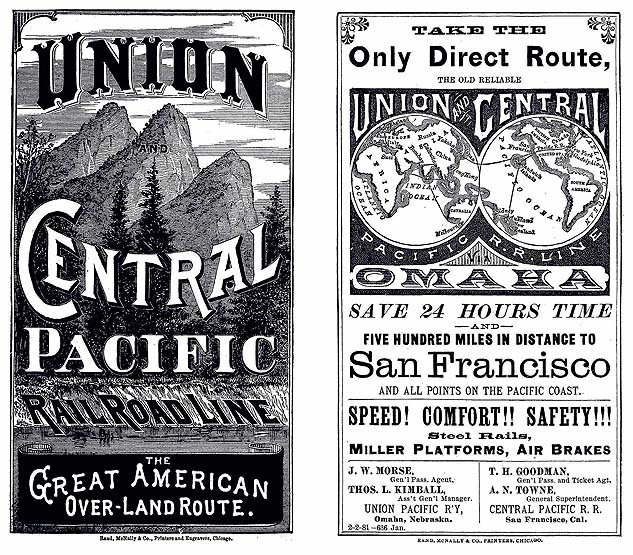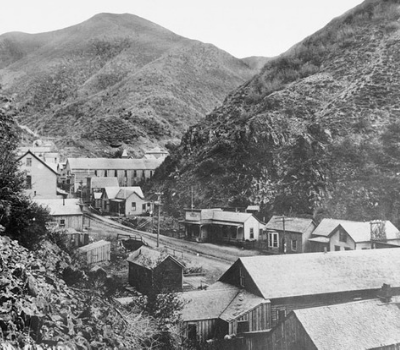On May 10th, 1869, the world’s first transcontinental railroad was completed connecting the eastern United States to the western United States. From the groundbreaking ceremony in Sacramento, California, on January 8th, 1863, to the “Golden Spike” ceremony at Promontory Summit, Utah, it took six years to complete. The men who built it came from many walks of life, from Irish men looking for gold, Chinese immigrants fleeing from war and famine in their homeland, and Civil War veterans. The completion of the railroad made the trip across the United States go from a 6-month wagon-train journey to a 7-day train journey.


The first trains appeared in America in 1830. Dreams to connect the east to the west began to form. Funding and a route needed to be decided on first. Bills were presented but did not pass until July 1st, 1862 when President Abraham Lincoln signed the “Pacific Railway Act” that funded the railroad with land grants for every mile of track laid. The route would be a central route starting at Omaha, Nebraska, and Council Bluff, Iowa, heading west, and Sacramento, California, heading east. The two companies to build the railroads were the Central Pacific Railroad and the Union Pacific Railroad.
KEY PLAYERS
Theodore Judah was a central figure for pushing the transcontinental railroad. He was a civil engineer who designed the route for the railroad to go across the country and did a lot of the survey work for the best route through the Sierra Nevada mountains. His determination to have the railroad cross the country gave him the nickname of “Crazy Judah”. In 1861, the Central Pacific Railroad was authorized by Congress and Judah became the chief engineer. Judah died in 1863 of Yellow Fever and never saw his work finished.

THE BIG FOUR
Funding to build the railroad came from four merchants in Sacramento. These men of the Central Pacific Railroad were known as the “Big Four”: Leland Stanford, President; Collis Huntington, Vice President; Mark Hopkins Jr., Treasurer; and Charles Crocker, Construction Supervisor.
Leland Stanford was a successful businessman, running general stores and engaging in mercantile pursuits. He served as the 8th Governor of California from 1862 to 1863.

Mark Hopkins opened a successful wholesale grocery store. He was so thrifty that he could “squeeze 106 cents out of every dollar”Yenne, Bill (1985). The History Of The Southern Pacific. Bison Books Corp. p. 11

Collis Potter Huntington was also a successful businessman. He ran a wholesale firm that specialized in mining supplies.

Charles Crocker was a self made successful hardware merchant. He invested his earnings to help form the Central Pacific Railroad.


Thomas Durant was vice-president of the Union Pacific Railroad. He was in charge of raising funds to build for the Union Pacific. Selling stocks was difficult for Durant, and federal legislation said that no partner could own more than 10% of stocks. He ended up controlling about half of the stocks for the Union Pacific Railroad by convincing other investors to let him buy stock using their names.
UNION PACIFIC RAILROAD
The Union Pacific Railroad company started in Omaha Nebraska and headed west. The route for the railroad followed the Oregon, Mormon and California Trails across Nebraska and Wyoming.
Work on the railroad started in July of 1865. Due to the Civil War, supplies and laborers were hard to come by. The Central Pacific Railroad had started work 18 months earlier. When the war ended Supplies were still hard to get since other northern and southern lines were in the process of repairing their lines.
When the Civil War ended, the railroad company hired war veterans. Men that were fighting against each other, were now working together to join the country.


As the Union Pacific moved west, the delays that faced them were building bridges across the rivers and creeks that they came in contact with. When they reached the point where the Platte river forked into the North and South Platte Rivers, the company had to build a 2,600-foot long bridge. Another bridge that they had to build was Dale Creek Bridge, which was 650 feet long and 125 feet above the creek.
When the Union Pacific reached the Utah Territory, thousands of members of the Church of Jesus Christ of Latter-Day Saints joined the workforce. The Wasatch Mountains were the challenge for the railroad. With the Help of the members of the Church of Jesus Christ, they were able to build tunnels, trestles, and bridges. The work through the Echo and Weber River canyons was completed in 6 months and reached Ogden Utah on March 27, 1869. Just over a month later, the Union Pacific Railroad company made it to Promontory Summit.
The Union Pacific Railroad began work in July of 1865. They laid 1,087 miles of track.
CENTRAL PACIFIC RAILROAD

The Central Pacific Railroad company started in Sacramento and headed east. Several problems lay ahead of the Central Pacific Railroad. One of them was getting supplies. All supplies to build the railroad had to come from the east. This included the iron rails, switches and the trains with all the cars. All of these would be placed on ships in the east and would take a journey around South America’s Cape Horn. When it reached San Francisco, the cargo was placed on steamboats to go up the river to Sacramento.
Finding workers to build the railroad was also difficult. Irish immigrants were hired at first, but mining for gold was more appealing to them.
California became home to thousands of Chinese immigrants that came over for the gold or escaping poverty and the Taiping Rebellion. As a trial run the CPRR hired 50 Chinese immigrants to see if they could do the work. The “Big Four” were impressed and thousands of Chinese immigrants began the hard labor of building the railroad through the Sierra Nevada Mountains.
Building the railroad up and over the Sierra Nevada Mountains was, perhaps, the greatest human achievement of that time. With only hand tools and wheelbarrows, the laborers worked at cutting, blasting, and moving tons of granite rock. At first, they used gunpowder to blast rocks, but when nitroglycerin was invented they used that, despite it being very unstable and it could blow up with a slight bump. It took over 2 years to get through the mountains. Eleven tunnels were made through the granite canyon walls. The workers built tunnels and bridges. Sheds were built over other areas of the track to protect the track from being knocked out by avalanches.
After conquering the mountain, it was across the deserts of Nevada and Utah. As they approached their end goal in Utah, they set a new record: 10 miles of track laid in a single day. This still has not been beaten as of September 5th, 2020
For the Central Pacific Railroad, groundbreaking happened on January 8, 1863. The company laid 690 miles of track.

GOLDEN SPIKE CEREMONY
May 10, 1896, two trains faced each other, Union Pacific’s train no. 119 and the Central Pacific train Jupiter (No.60). “DONE” was sent across the transcontinental telegraph system. The two companies laid down the ties. The ceremonial “golden spike” was hammered in by Leland Stanford. No one knows how many people were are the ceremony as number range from 300 people to as many as 3000 people.

AFTERMATH

